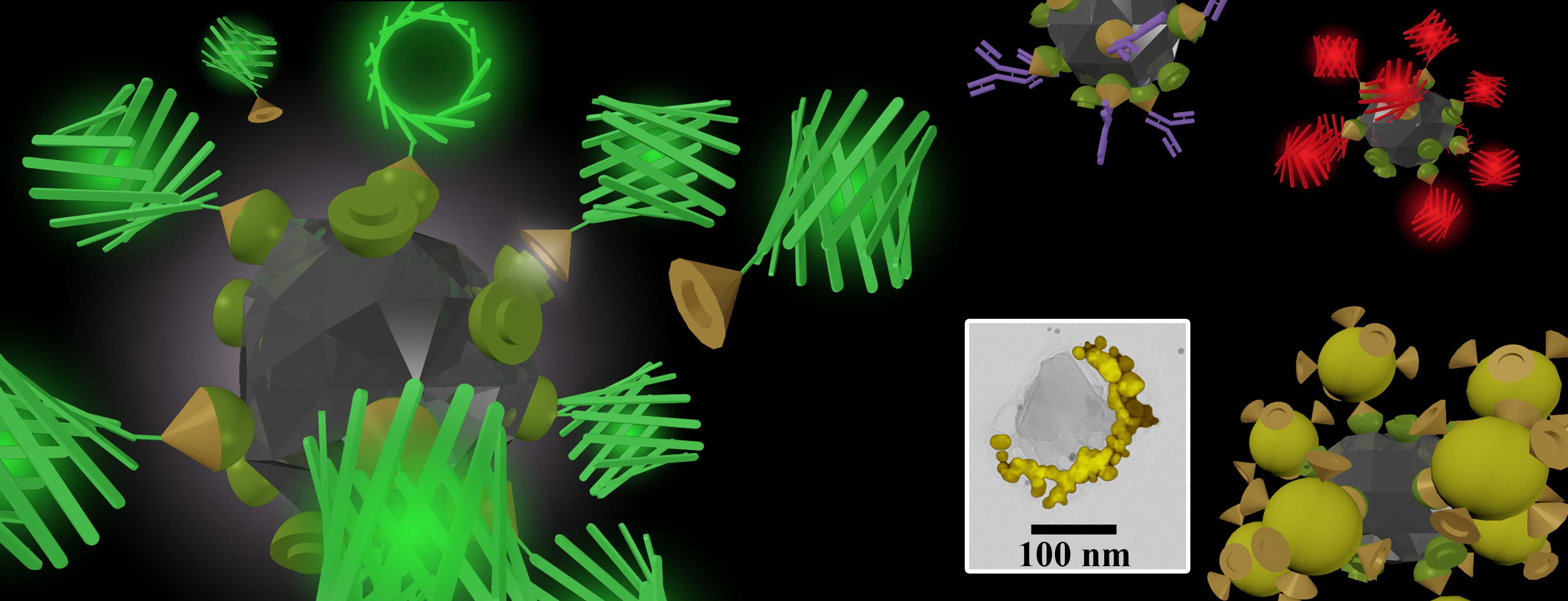Stream 2 – Production of Biocompatible Nanocomplexes: Surface Functionalisation and Bioconjugation
Surface Functionalisation
Oftentimes, nanoparticles (NPs) are hydrophobic and hence incompatible with most biological media. NP surface must be redressed to make NPs stable in water. We developed several surface functionalisation procedures based on amphiphilic polymers that represent molecules with hydrophobic and hydrophilic terminals. While their hydrophobic terminals anchor hydrophobic moieties of the NPs, their hydrophilic terminals become exposed outwards rendering the nanoparticle hydrophilic, i.e. stable in aqueous solutions. Additional stability of the buffer solutions is achieved by coating the surface with modified proteins or polymers such as polyethylene-glycol.
Nanorubies produced by the laser ablation method represent a remarkable exception among the other luminescent nanomaterials -- they are stable in water, as produced, and, more to this, form stable colloids in buffer solutions!
Bioconjugation
In order to interface the NP with a biological world, one needs to decorate NP with biomolecules that can furnish biologically meaningful interaction of the NP and, for example, a cell. Bioconjugation is used as the procedure to graft these biomolecules onto the NP surface. In collaboration with Prof. Deyev's group (Shemyakin & Ovchinnikov Institute of Bioogranic Chemistry, the Russian Academy of Science, Russia), we implemented an optimised facile, pot-mix methodology to assemble the nanoparticulate biocomplex by choosing a high-affinity molecular pair avidin:biotin or barnase: barstar (Bn:Bs), as a stable strong-bonding molecular linker, as schematically presented in Figure on an example of the assembling nanodiamond bioconjugates.

Figure. Diagram of a universal platform for bioconjugation of macromolecules and nanoparticles to the surface of the nano-carrier for the nanodiamond example. Covalently bound to the surface of nanodiamond barstar protein molecules (green hemisphere) capable of selectively and strongly binds to a molecule barnase (brown cones), which, in turn, pre-conjugated with the desired macromolecules, such as green fluorescent protein (fragment left) antibody (fragment above) or nanoparticles, such as nanogold (detail below). Transmission electron microscopy shows the structure of the compound nanodiamond nanogold-called "nano-tiara" (micrograph in the lower right corner) [1].
1. Sreenivasan VKA, Ivukina EA, Deng W, Kelf TA, Zdobnova TA, Lukash SV, Veryugin BV, Stremovskiy OA, Zvyagin AV, Deyev SM: Barstar:barnase - a versatile platform for colloidal diamond bioconjugation. Journal of Materials Chemistry 2011, 21:65-68.